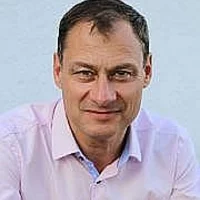Biography
Nicholas Plumb completed his PhD in 2011 at the University of Colorado, where he performed spectroscopic studies of cuprate high-Tc superconductors and helped to develop the technique of laser-based angle-resolved photoemission spectroscopy (laser-ARPES). He came to PSI as a postdoc, working at the SIS beamline of SLS, where he focused on combining synchrotron-based ARPES with in situ thin film growth in order to study novel oxide materials, interfaces, and surfaces. He became a staff scientist at the beamline in 2013 and has held a permanent PSI staff position since 2017.
Institutional Responsibilities
Dr. Plumb conducts research within the Spectroscopy of Quantum Materials group. He is also contributing to the design and realization of the new QUEST beamline for ARPES in SLS 2.0.
Scientific Research
Dr. Plumb’s research focuses on spectroscopic investigations of quantum materials in which many-body interactions give rise to surprising and promising new phenomena, such as high-temperature and/or unconventional superconductivity, metal-insulator transitions, colossal magnetoresistance, colossal thermopower, and so on. He is involved in the development of instrumentation and methods for photoemission spectroscopy at the Swiss Light Source.
Selected Publications
For an extensive overview we kindly refer you to our publication repository DORA.
Strong- to weak-coupling superconductivity in high-Tc bismuthates: Revisiting the phase diagram via μSR, T. Shang, D. J. Gawryluk, M. Naamneh, Z. Salman, Z. Guguchia, M. Medarde, M. Shi, N. C. Plumb, and T. Shiroka, Physical Review B 101, 014508 (2020).
Understanding how perovskite bismuth oxides (bismuthates) can superconduct at temperatures over 30 Kelvin is a longstanding problem that may give insights into other high-Tc superconductors, as well as a more general view of strong electron-phonon interactions. With partners in the NUM department of PSI, we extended the phase diagram of Ba1-xKxBiO3 to exceptionally high K doping, and established a crossover from strong- to weak-coupling superconductivity as the hole doping exceeds the point at which optimal Tc occurs.
Angle-resolved photoemission spectroscopy studies of metallic surface and interface states of oxide insulators, Nicholas C. Plumb and Milan Radović, Journal of Physics: Condensed Matter 29, 433005 (2017).
Low-dimensional metallic states in oxide systems hold enormous promise for novel electronic and spintronic devices, and they can also serve as platforms for fundamental research into the exotic phenomenology of oxides. This Topical Review article surveys recent progress in using ARPES to discover and understand metallic states that can be realized on the surfaces of bulk-insulating oxide materials, or at interfaces between them.
Evolution of the SrTiO3 Surface Electronic State as a Function of LaAlO3 Overlayer Thickness, N. C. Plumb, M. Kobayashi, M. Salluzzo, E. Razzoli, C. E. Matt, V. N. Strocov, K. J. Zhou, M. Shi, J. Mesot, T. Schmitt, L. Patthey, and M. Radović,. Applied Surface Science 412, 271-278 (2017).
The discovery of a confined metallic state formed at the interface between insulating LaAlO3 and SrTiO3 spurred significant interest – both in its fundamental origins and properties, as well as its potential uses in novel devices. Later revelations by ARPES that a metallic state could also be formed on the surface of bare SrTiO3 brought even more possibilities for creating and manipulating such systems, along with a number of new questions. We used ARPES, resonant inelastic x-ray scattering (RIXS), and PLD film growth to investigate how the SrTiO3 surface state evolves as LaAlO3 is grown on top of it. Overall our study found a striking connection in the band structures of the bare and buried metallic states, but we also observed a new structural order at the interface when LaAlO3 exceeds a critical thickness.
Momentum-Resolved Electronic Structure of the High-Tc Superconductor Parent Compound BaBiO3, N. C. Plumb, D. J. Gawryluk, Y. Wang, Z. Ristić, J. Park, B. Q. Lv, Z. Wang, C. E. Matt, N. Xu, T. Shang, K. Conder, J. Mesot, S. Johnston, M. Shi, and M. Radović, Physical Review Letters 117, 037002 (2016).
We experimentally determined the electronic structure of BaBiO3 – an insulating parent compound of the superconducting bismuthates – by performing ARPES on films prepared in situ using PLD. We found that BaBiO3’s unusual electronic phase is best described as a “bond-disproportionated insulator,” where charges pair within molecular-like orbital combinations of the oxygen atoms.


